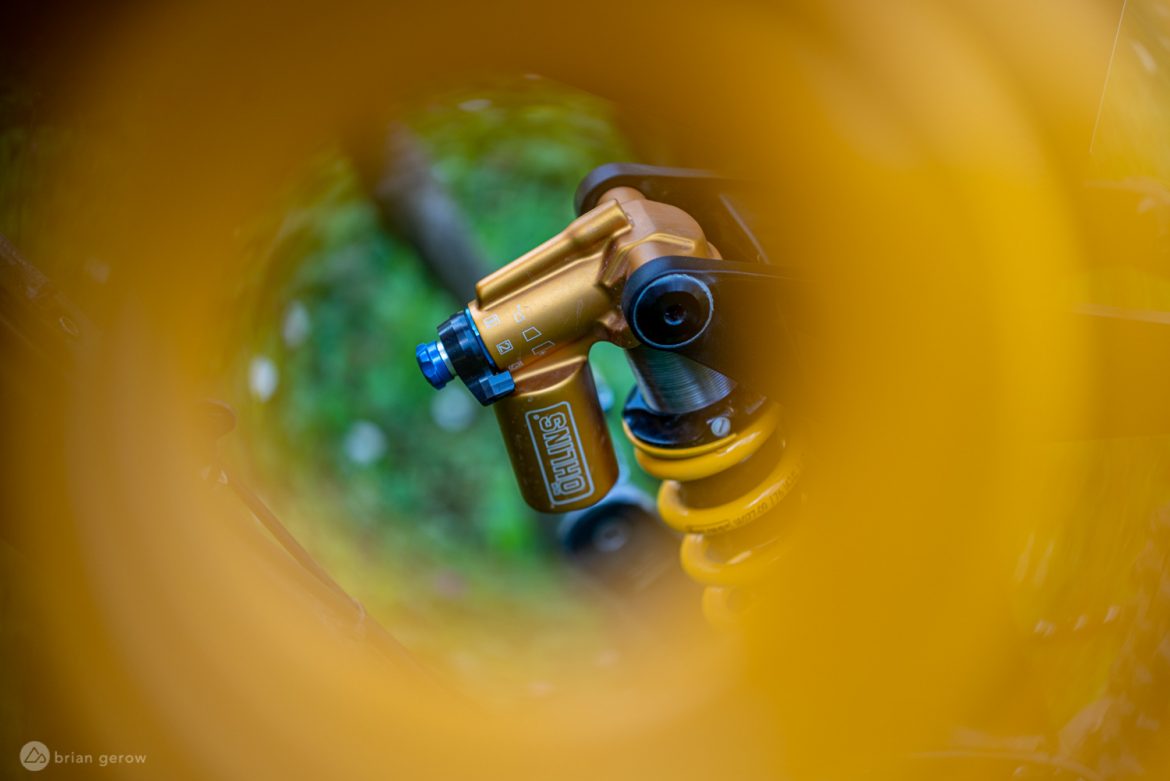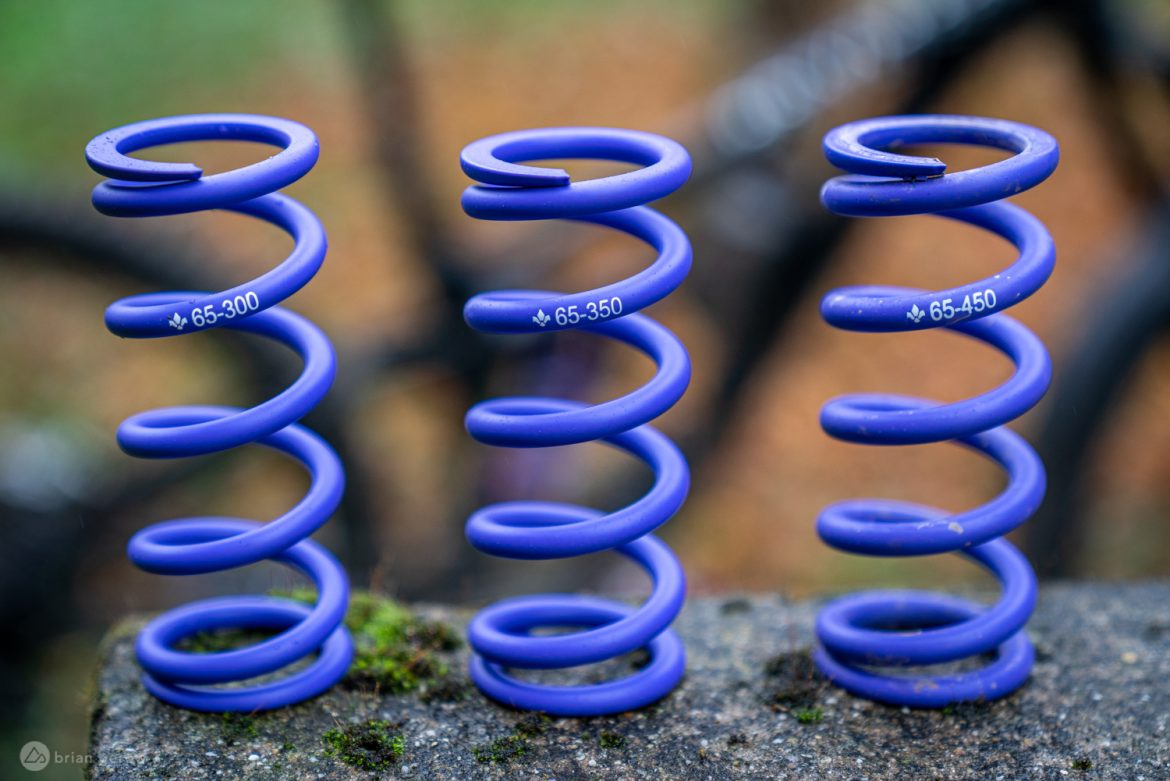After nearly three years of testing coil shocks on my daily trail drivers, I recently returned to an air spring and wanted to share some of the notable differences. While I also rode test bikes with air shocks, the mountain bikes that I’m intimately familiar with have been steel-sprung for a long while. I didn’t fully appreciate the difference between the two spring options until switching back to air with the 2022 Fox Factory Float X.
I nearly went over the bars while landing a jump on my first outing with the Float X, as I pushed into the bike with the amount of force I would typically give a coil. I had to slow down the rebound for a few rides and adjust my riding style to the return energy, and it’s since clicked back up to a comfortable speed. This may seem ridiculous to a lot of folks, but the coil spring and I dug a deep groove in one anothers’ habit centers.
Let’s begin with the classic divide between air and coil: the pop and circumstance. Well, maybe it’s pop and suppleness. The air pressure in an air-sprung shock increases as the shock compresses, creating higher pressure that’s described as “ramp up” or progressivity. The progressivity inherent in the suspension design adds to that equation. That progressively increasing pressure also springs back harder at the beginning of the return, and it’s the job of the rebound-damping circuit to regulate how quickly that happens. Coil springs, however, compress and return at a constant rate throughout their travel, and the frame’s progressivity takes care of the spring curve — aided toward the final few centimeters by the bottom-out bumper and/or a hydraulic bottom-out system. Yes, there are progressive coil springs, but their ride character remains fairly distinct from air. I typically choose an air or coil spring based on the particular frame’s rate of progressivity and fine-tune things from there, though I will say I prefer the consistency a coil creates on the roughest trails.
An extension of this well-known difference is the notion that coil shocks require less force to initiate compression than air, which results in better grip over trail chatter and improved small bump compliance. While this seems true and can be felt in the dirt, a high-quality air shock will feel fairly close to as supple and grip-happy as a comparable coil. Where the difference really rears its head is deeper in the travel when the air shock increasingly resists the rear axle-travel and a standard coil remains as linear as the frame will allow. The more progressive curve helps the bike pump and pop out of compressions and off impacts, where the coil’s linear character keeps it consistently smooth and stable throughout. From there it’s all up to personal preference.
I enjoy a coil when the trail will be extra rough and unpredictable, keeping the bike a touch more composed at high speed. If the option is available, I would swap in an air shock for trails I know well, and when pumping and jumping are the primary goal. That’s a somewhat common scenario in gravity racing, and there are nuances and totally different ways to look at those same factors. Fortunately, if you’re not trying to win a World Cup DH weekend, both springs can work well in most cases.
Another glaring distinction between air and coil-sprung shocks is the adjustability of the air spring. Not only is the resistance force of an air spring infinitely adjustable with a pump, but the rate with which it becomes progressive can also be adapted to different riders, styles, and trails. Riders can drastically change how an air shock or fork performs by adding or removing volume spacers to increase or decrease the amount of force required to compress the end of the component’s stroke. A coil shock requires that the spring be swapped in order to boost or reduce its spring rate, unless you purchase a Sprindex spring for the shock that allows for quick adjustments with one wound hunk of steel — within a 50lb/in window. Unfortunately, the linear curve of a standard coil can’t be adjusted, and I have yet to ride a “progressive coil” that added enough pop to satisfy the moments when I would prefer an air shock. I will keep trying progressive coil springs to see if there’s a dialed middle ground.

Heat dissipation is another reason some folks enjoy coil shocks. The process of air compressing and expanding over and over again creates heat, and coil shocks inherently negate that issue. Air shocks also tend to require more seals to retain their compressed gasses and those cause additional heat-creating friction. On long and rough descents that heat will transfer to the oil in the damper, thinning it out and allowing it to pass through the compression and rebound circuits faster. Racers used to joke that when this happened the shock made their bike feel like a hardtail at the end of a fast race lap, though most gravity air shocks today deal with heat dissipation far better. Fast riders will likely feel a difference at the end of a rough descent that’s longer than ten-ish minutes, but if the rear wheel truly absorbs impacts as poorly as a hardtail there is likely something wrong inside the shock. I have experienced a few air shocks that harden and stopped kicking out the grip on longer descents, which is one of the reasons I will typically take a coil if it’s available, but it’s less common today than it was a few years ago.
Additionally, there seems to be a larger difference in performance and on-trail feel between air shock brands and models than with coils. I have tested some amazing coil shocks, and it can be difficult to sense the meaningful elements that might make one shock distinct from another. As a result, I like to test coils for a full season before writing a review. With air shocks, the defining characteristics are often more readily apparent. Between the damper clicks and the way they ramp up, air springs make sure you know their name.
Lastly, coil shocks also weigh more, across the board. Even massive air cans like the one on a Fox X2 are lighter than a wound-up stick of steel. A lot of gravity riders prize performance above grams, but when your 160mm mountain bike weighs 17kg it might be worth weighing the benefits of a coil before selling the compressed gas squisher. I get to ride most days, maintaining enough fitness that the weight of my bike doesn’t affect my ride too much, but I also wouldn’t mind if it shed a few grams.
Apart from the holiday albums, every Dolly Parton record is great in its own way, perfect for a particular mood or day. Coil and air shocks sit similarly in subjective space, ready to be the best option depending on the dance.






















8 Comments
Dec 15, 2021
Dec 16, 2021
Dec 16, 2021
Dec 16, 2021
Dec 21, 2021
Would not consider a coil ever again for a bike unless it had a minimum of 35% total progression.
Ultimately, I just find air shocks to be much better on mountain bikes.
Dec 23, 2021
Dec 23, 2021
Dec 15, 2021